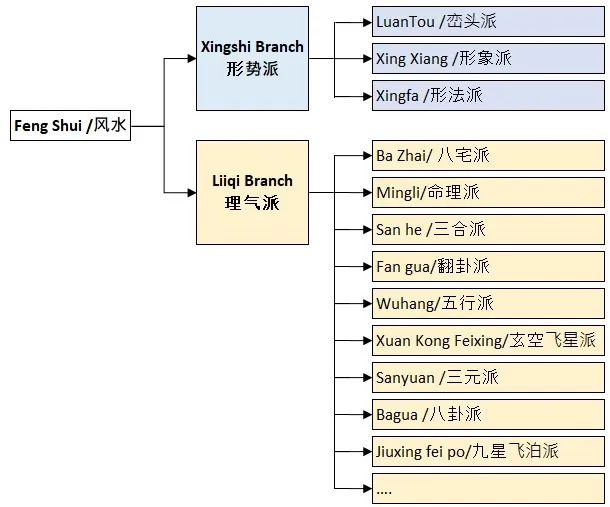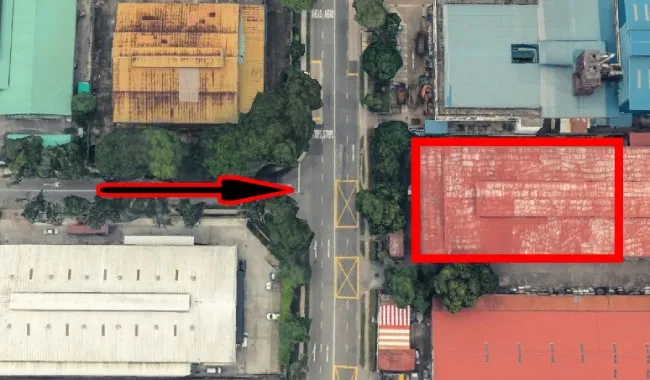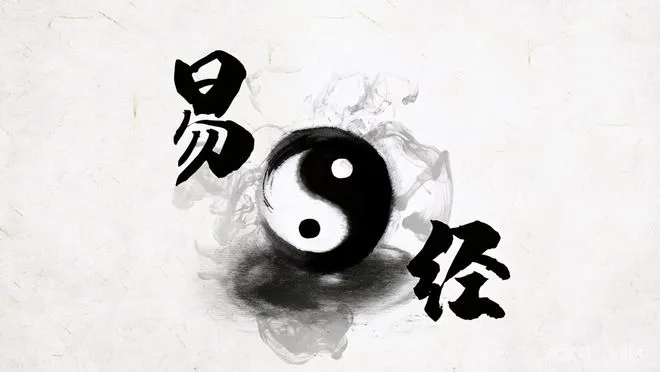Branches of Feng Shui - Xingshi and Liiqi
After thousands of years of development, Feng Shui has gradually formed many different branches, in general, there are two main branches: The xingshi branch or Form Branch形势派and the Liiqi branch or Compass Branch理气派

I. Xingshi Branch or Form Branch形势派
History
The first people to evaluate good or bad destiny based on the Xingshi Branch were Quan Nhan管辂and Guo Pu郭璞in the Wei and Jin dynasties. This is also the oldest branch of feng shui. In the Tang Dynasty, Yang Junsong杨筠松inherited their views and further developed the Xingshi Branch theory based on the original theory.
Theory
Their theoretical perspective is to "collect qi and hide the wind"聚气藏风, taking the shape of mountains and water, taking the theory of elements: (dragon龙, cave穴, sand砂and water水) as the basis to determine good or bad luck.
The main operating methods are “the method of touching the ground and tasting the water”相土尝水法and “the method of surrounding the mountain of water”山环水抱法. Its theory is “carry yin embracing yang”负阴抱阳, “have qi surrounding mountains and water”山环水抱必有气, and the five geographical secrets are “find dragon觅龙, observe sand察 砂, acupressure点穴, water observation观水and orientation取向”. The Xingshi Branch has rich practices, and few taboos, and is easily accepted and understood by everyone, so its spread is relatively wide.
Sub-branches
Xingshi Branch is further divided into three sub-branches, which are related and not completely separate:
1. LuanTou Branch峦头派
Pay attention to the geographical situation, and mainly use "dragon, cave, sand, water and direction" to discuss good and bad luck.
Luantou represents the natural landscape of mountains and rivers. The natural geographical mountains include dragon, sand, and mountain. Dragon refers to the mountains extending in the distance; sand refers to the hills within a range of 360 degrees around the cave site; Mountain refers to the peak in the distance outside the cave site.
2. Xing Xiang Branch形象派
When observing mountains and water, compare their shape to an object or event. By doing so, one can visualize the mountain's shape as a certain animal or object, which can be used to speculate on the good or bad luck associated with it. For example, if a mountain looks like a bird, a lion, or a rhinoceros, it can be interpreted in different ways.
This practice is known as "形象" in Feng Shui, and it is a profound knowledge. When the image of a mountain is vividly regarded as a certain animal or other object, it can be associated with many different names, such as "beauty looking in the mirror" or "seven stars accompanying the moon", etc.
3. Xingfa Branch形法派
On the basis of the Xing Xiang Branch, some principles of the Luantou Branch are used to discuss the method of combining images with acupuncture points.
For example: In the same direction as the house, "dragon on the left and tiger on the right", and the right side is the tiger side. If the tiger side is longer and higher, it is called "white tiger probe"白虎探头in architectural Feng Shui. Or if there is a ditch rushing straight in front of the door, it is called "An arrow piercing the heart"一箭穿心, etc. These are all shapes and structures that are considered very unlucky in Feng Shui. It is something that should be avoided when building houses and surroundings.

II. Liiqi Branch or Compass Branch理气派.
History
Liiqi Branch理气派or Compass Branch, also known as the Fujian Branch福建派, originated from Fujian.
Liiqi Branch was founded by Wang Ji王及, Chen Tuan 陈抟and others during the Song Dynasty, mainly operating in Sichuan, Zhejiang and Fujian.
Theory
The Liiqi branch of Feng Shui was developed based on the Xingshi branch. It incorporates the "Book of Change - I Ching"易经and astrological theory to understand how the celestial bodies in the universe affect the human body.
Specifically, The Liiqi branch includes most of the contents of the "I Ching"易经:
- Yin and yang阴阳.
- Five elements五行.
- Hetu河图.
- Loushu洛书.
- Bagua八卦 .
- Xingxu星宿.
- Shensha神煞.
- Nayin纳音.
- Qimen奇门.
- ...ect.

The Liiqi branch emphasizes the relationship between the environment and people, making it more practical in everyday life. The theories of this branch are quite intricate, with each theory having a distinct emphasis, leading to the creation of several smaller branches.
Sub-branches
Major branches include: Ba Zhai八宅派, Mingli命理派, San he三合派, Fan gua翻卦派, Wuhang五行派, Xuan Kong Fei Xing玄空飞星派, etc.;
Sub-branches include: Sanyuan三元派, Bagua八卦派, Jiuxing Feibo九星飞泊派, etc.
III. Conclusion.
Regarding the Feng Shui branches, in general, they are nothing more than the Xingshi and Liiqi branches. The theories of these two branches are intertwined and interconnected, like the front and back of a coin, both are indispensable. Therefore, Feng Shui practitioners must grasp the essence of both branches. It is necessary to master the theory of the Liiqi branch and absorb the essence of the Xingshi branch, both are indispensable. But one thing must be clearly understood: no matter what branch of Feng Shui you study, you must eliminate the fake and keep the real, eliminate the gross and choose the fine, never misunderstand.